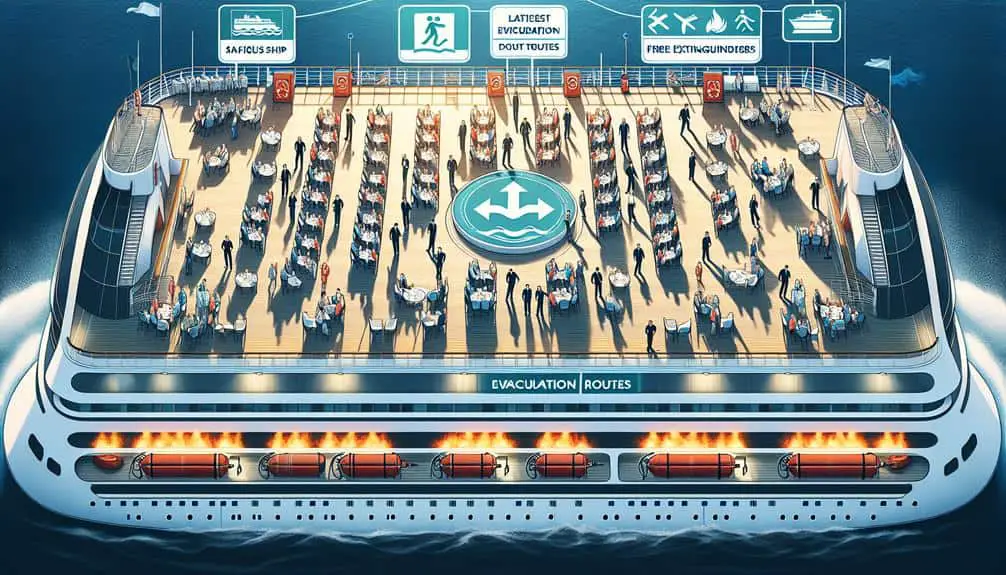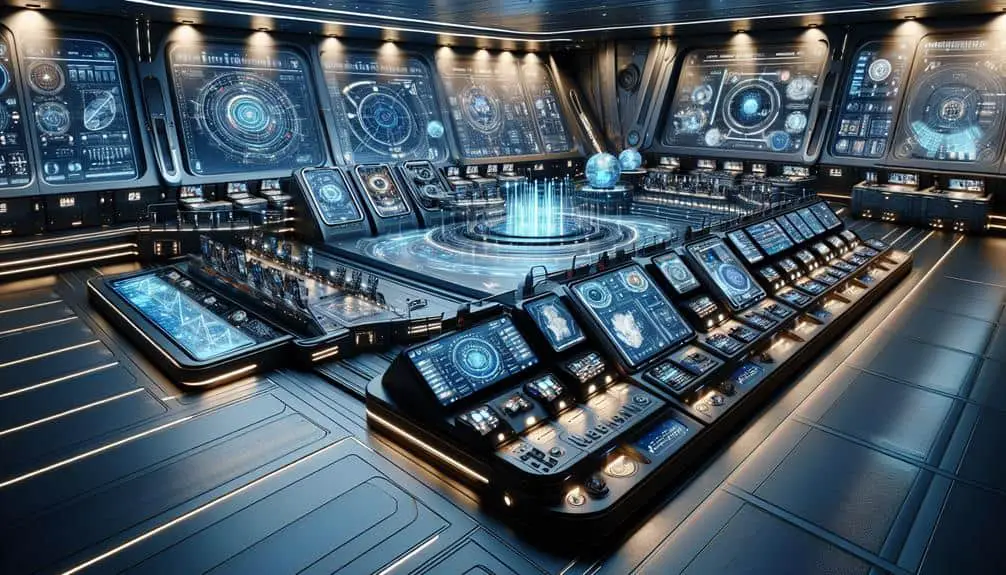Upgrade to advanced fire detection systems with continuous monitoring and immediate alerts for swift identification of fire hazards. Implement automatic fire suppression technology using water mist and foam to combat fires effectively. Enhance evacuation protocols through regular drills and crew training for efficient response. Utilize real-time monitoring for prompt detection of anomalies and quick coordination of evacuation procedures. Prioritize crew fire safety training with routine drills and hands-on simulation. Stay informed about the latest cruise fire safety measures to guarantee a safe journey onboard.
Key Points
- Upgraded sensor technology for early fire detection.
- Water mist and foam suppression systems for critical areas.
- Regular fire safety training for crew members.
- Real-time monitoring for swift anomaly detection.
- Enhanced evacuation protocols with regular drills.
Advanced Fire Detection Systems
To guarantee the highest level of safety onboard, cruise ships are equipped with state-of-the-art advanced fire detection systems. These systems utilize upgraded sensor technology to detect even the smallest traces of smoke or rise in temperature. By employing essential prevention strategies, such as continuous monitoring and immediate alerts, these systems can swiftly identify potential fire hazards before they escalate.
The enhanced sensor technology integrated into these fire detection systems ensures a rapid and accurate response to any sign of fire onboard. These sensors are strategically placed throughout the ship, including in engine rooms, kitchens, and other high-risk areas. Their ability to detect anomalies in air quality or temperature variations allows for early intervention, critical in preventing fire outbreaks.
Furthermore, the essential prevention strategies implemented alongside these advanced systems enhance the overall safety measures onboard cruise ships. Through real-time monitoring and instant notifications, crew members can swiftly address any emerging fire threats, thereby minimizing the risk of fire-related incidents. The combination of upgraded sensor technology and essential prevention strategies significantly elevates the fire safety standards on modern cruise ships.
Automatic Fire Suppression Technology
The implementation of automatic fire suppression technology on modern cruise ships revolutionizes onboard safety measures by swiftly containing and extinguishing fires in critical areas. These systems utilize advanced mechanisms such as water mist and foam suppression to effectively combat fires.
Water mist systems work by discharging a fine mist of water droplets that rapidly cool the fire, lower the oxygen levels, and suppress the flames. This technology is particularly useful in areas where traditional sprinkler systems may not be suitable, such as engine rooms or kitchens where grease fires are a concern.
On the other hand, foam suppression systems work by releasing a blanket of foam over the fire, smothering it and preventing the flames from spreading. This method is highly effective in dealing with fires involving flammable liquids or gases.
The integration of these automatic fire suppression technologies enhances the overall fire safety preparedness on cruise ships, providing a quick and efficient response to potential fire hazards in critical areas, ultimately ensuring the safety of passengers and crew members.
Enhanced Evacuation Protocols
When evacuating a cruise ship during an emergency, passengers and crew members must adhere to the vital protocols meticulously crafted to guarantee a swift and orderly evacuation process. Emergency drills play an essential role in preparing everyone onboard for potential evacuation scenarios. These drills are conducted regularly to familiarize passengers with evacuation routes, assembly points, and safety procedures. Additionally, crew members are trained to efficiently assist passengers during evacuations, ensuring passenger safety remains the top priority.
In the event of an emergency, passengers are instructed to follow crew members' directions promptly. Designated muster stations are assigned to each passenger, and it's essential to proceed to these locations calmly and swiftly. Enhanced evacuation protocols also emphasize the importance of maintaining situational awareness and helping others, especially those with mobility issues, children, or the elderly, to reach safety. By practicing these protocols and actively participating in emergency drills, passengers and crew members contribute to a safer cruise environment and better preparedness in challenging situations.
Real-time Monitoring and Alerts
Incorporate real-time monitoring systems on cruise ships to guarantee rapid detection and immediate response to potential safety hazards. These systems offer remote monitoring capabilities, enabling continuous surveillance of critical areas. Through sensors and cameras strategically placed throughout the ship, these systems can detect anomalies in temperature, smoke, or gas levels, triggering alerts for the crew to investigate promptly.
Emergency response readiness is greatly enhanced with real-time monitoring. When a potential hazard is detected, alerts are immediately sent to the designated personnel, allowing for swift action to mitigate risks. Crew members can quickly assess the situation, implement necessary safety protocols, and coordinate evacuation procedures if needed.
Fire Safety Training for Crew
Implementing a comprehensive fire safety training program for crew members aboard cruise ships is essential to ensure a swift and efficient response in case of emergencies. Crew members play a crucial role in ensuring the safety of passengers and the vessel itself during a fire incident. Here are key elements to contemplate when conducting fire safety training for crew:
- Regular Crew Drills: Schedule routine fire drills to acquaint the crew with emergency procedures and the operation of firefighting equipment.
- Emergency Response Protocols: Educate crew members on how to respond promptly to fire alarms, establish communication channels, and coordinate evacuation procedures.
- Hands-On Firefighting Training: Provide practical training on using fire extinguishers, hoses, and other firefighting tools to effectively combat onboard fires.
- Crisis Management Simulation: Conduct simulated fire scenarios to assess the crew's ability to handle high-stress situations and make quick decisions under pressure.
Frequently Asked Questions
How Often Are Fire Drills Conducted on Cruise Ships and How Are Passengers Notified?
During cruise ship journeys, fire drills are conducted regularly for safety. The crew's responsibilities include organizing and executing these drills. Passengers are informed through announcements and written instructions, ensuring everyone is prepared for emergencies.
Are There Regulations in Place for the Types of Materials That Can Be Used in the Construction of Cruise Ships to Prevent Fires?
To guarantee safety, construction regulations for cruise ships meticulously outline materials to prevent fires. Stringent guidelines dictate the types of substances permissible, creating a robust system that minimizes fire risks at sea.
How Are Passengers With Mobility Issues or Disabilities Accounted for in Evacuation Protocols?
In cruise ship evacuation procedures, passengers with mobility issues or disabilities receive specialized evacuation assistance. Emergency communication systems are equipped to provide tailored instructions. Safety drills include specific protocols for these individuals to guarantee their safety during emergencies.
What Measures Are in Place to Prevent Fires From Spreading Between Cabins or Sections of the Ship?
To prevent fires from spreading between cabins or ship sections, fire doors with automatic closing mechanisms are installed. These doors aid in fire containment by limiting the oxygen supply. Additionally, effective ventilation systems help clear smoke for emergency communication and safe evacuation.
Are There Any Specific Safety Measures in Place for Children or Elderly Passengers in Case of a Fire Emergency?
In case of a fire emergency on a cruise ship, specific safety measures for children and elderly passengers include clear evacuation protocols, designated meeting points, and trained crew members to assist in guiding them to safety efficiently.




